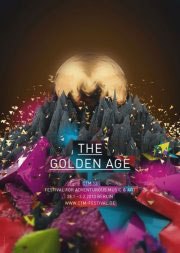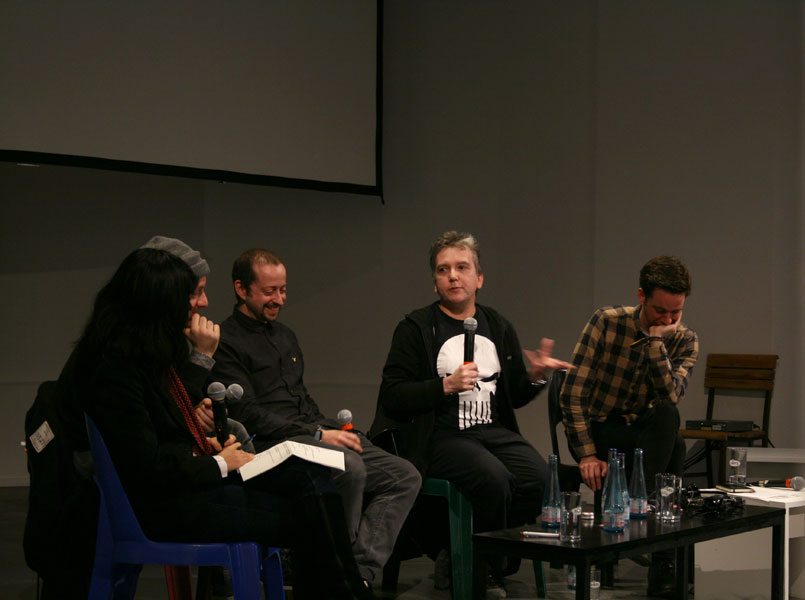You Its Eyes 94-13m :: 2013
Video length: 31 mins
You Its Eyes 94-13. CTM13, Berlin :: 2013
You Its Eyes 94-13. CTM13, Berlin 2013
 This remix for the Death Of Rave and Virtual Futures programme, was commissioned by Annie Goh and showcases the best of 0D’s 90’s video with tracks made by longtime collaborators Ocosi and Kode 9.
This remix for the Death Of Rave and Virtual Futures programme, was commissioned by Annie Goh and showcases the best of 0D’s 90’s video with tracks made by longtime collaborators Ocosi and Kode 9.
0rphan Drift: You Its Eyes 94-13
Screening of video works by 0rphan Drift
In this specially commissioned audiovisual work, 0rphan Drift remix their rave-inspired works from the mid to late1990s. This period was characterized by a distinctly analogue, lo-fi materiality. Accompanied by audio from 0D’s Ocosi, Surface and Sadist, and by sound made for the 0D/CCRU “Syzygy” collaboration in 1999, remixed by CCRU’s Kode9, this screening is a hallucinogenic immersive experience, a meditation on rave, techno culture, and its posthuman potentialities.
The influence of rave and digital music technologies are affirmed as the dancefloor repeatedly appears as a philosophical arena. 0D was a source of inspiration for CCRU, sharing similar fascinations, collaborating together, and artistically activating many key theoretical concepts. OD collaborated with Nick Land on his ’95 and ’96 Virtual Futures performances, Meltdown and Katasonics, before developing the complex, month-long Syzygy event with CCRU, which provided a platform for the intense evolution and amplification of both groups’ fictional frequencies.
http://www.ctm-festival.de/festival/program/event/2013/02/01/orphan_drift
http://www.ctm-festival.de/festival/artists/orphan-drift
Click on a title below to expand/collapse texts
Oberhausen International Short Film Festival 2001, Germany
Preparation for essay ‘Seeing the Beat: Retinal Intensities in Electronic Music Videos.’ Simon Reynolds.
2000 The Videos. A Response. The effects resemble solarisation, video equivalents of audio production FX like flanging, phasing, ghosting, filtering etc — where there’s source material like stock footage or your own shooting, it’s extremely degraded and distorted — also there’s all these abstract, abject-looking pulses and filaments and oozings of color-texture – and there’s kaleidoscopic effects combined with abstract symbols and patterns — also seems to be a lot of flicker and strobe, and an effect that’s kind of trembling or wavering of the image. Generally it looks like you’re trying to do visually what you did with language in the OD book in the pieces evoking the disorientation and uncanny qualities of techno trance rave etc — Seeing the Beat: Retinal Intensities in Electronic Music Videos is about how the visual lags behind the sonic, it can’t have the same power to penetrate, subsume, enfold, irradiate etc our bodies that sound has, that terrible intimacy and proximity of the sonic whereas the visual has an inbuilt detachment and perspectival mastery of the field of vision — this lag between the two senses, and their corresponding artistic mediums, is something you’re trying to close with your video work. EXCERTS FROM “Seeing the Beat: Retinal Intensities in Techno and Electronic Dance Videos” by Simon Reynolds, 2000 Published in Festival Catalogue -Oberhausen International Short Film Festival, Mai 200 (Internationale Kurtzfilmtage Oberhausen) (In conjunction with the screening of ‘Spiderman’ video) “o[rphan]d[rift<], whose video work has featured in promos for songs, as back projected video-decor in clubs, and in multimedia gallery installations, also represent “the spirit of rave” in terms of form-dissolving, ego-melting, boundary-hemorrhaging femininity. They consciously articulate their work as an attempt to close the gap between the visual(traditionally regarded as the masculine sense) and the aural(traditionally regarded as female)…..The overall effect simulates a sort of retinal trembling, as though vision itself was wavering, the mindscreen buckling and crinkling. The eye is restored to its materiality as a jelly-like orb, a muscle capable of being stressed, strained,even injured, as opposed to a disincarnate, invulnerable perceptual apparatus.” “The ur-technique underlying o[rphan] d[rift<]’s work is the liberation of texture from its environment, of energy-flux from contoured form;the goal is to recreate “the intensity of being kind of lost.” “The O[rphan]d[rift<], cyberpositive, book describes the rave experience in terms of masochistic mortification of the flesh (“deep hurting techno”, “the violence of the sounds.its like you are being turned inside out,smeared,penetrated”), shamanic possession and voodoo oblivion(“white darkness”,”the fog of absolute proximity”) and “beautiful fear”.
Back to the Future? Technopolitics and the legacy of the CCRU. Alex Williams, Berlin, 01/02/13
Writing in 2011, the music critic, Simon Reynolds, recounted that:
“Once upon a time, pop [music]’s metabolism buzzed with dynamic energy, creating the surging-into-the-future feel of periods like the psychedelic sixties, the post-punk seventies, the hip-hop eighties, and the rave nineties. The 2000s felt different […] and as they continued the sensation of moving forward grew fainter.” 1
As the theorist Franco Beradi put it more pithily, in a recent book: “The future has been cancelled”. 2 This talk will explore the crossover between our present cultural moment, a moment of the end of the future, or even nostalgia for the future, and the legacy of a curious renegade academic entity, the Cybernetic Cultural Research Unit, in particular its leading theorist, Nick Land. Land’s ideas of machinic acceleration are important both to thinking rave and post-rave dance musics (in particular: techno, hardcore, and jungle), as well as to thinking capitalism. Land’s thought is by no means unproblematic though, and I will make clear some of the key problems with his thinking of acceleration. Then I will suggest that the influence of the CCRU on later thinkers may give us some guidance as to how to escape the impasses of our current cultural moment, through a reinvigoration of the idea of acceleration. This new idea of acceleration has to take us beyond the ambit of that suggested by both 90s dance music and 90s theory.
1. The Death Of Rave
Let’s begin with arguments around ‘the death of rave’. The roots of these debates can be found in the UK blog scene of the mid to late 2000s. The core of the argument, made most prominently by Simon Reynolds and Mark Fisher, was that there was an aesthetic, cultural, and social entity (termed by Reynolds the ‘hardcore continuum’) which was responsible for at least a decade of outstandingly creative music from rave itself, through hardcore, towards jungle and early grime. Then, so this argument runs, the wellspring of novelty and innovation runs dry some time around the emergence of dubstep in the early 2000s. This argument is extended by both theorists to encompass virtually all genres of musical production: four-to-the-floor dance genres like house and techno, rock, hip hop, metal, mainstream pop, even jazz and modern classical musics. However the most heated discussions centred on post-rave British dance music – as possibly one of the last areas in which the radically new was still operative. Even within this once fertile territory, the element of sonic ingenuity, of radical audio future shock, was no more.
The critics of the argument countered that, rather than being a case of cultural decay this was more an instance of particular commentators being ‘out of touch’, and moreover being unable to ‘keep up’ with the still vital pace of innovation in post-rave dance. This seemed to be somewhat of a misreading of the argument, which rather than decry new music as being so alienating as to be ‘not music at all’ (as might be more familiar in generational alienation), instead they found only banal repetition. “Shock us” they said, but no shock could convincingly be found. As Mark Fisher puts it: “Imagine playing a piece of mid-90s jungle to someone from the 1970s and they would be absolutely astounded. But play a piece of current ‘bass music’ to someone from the early 1990s, and there would be no such reaction.” 3
Where once popular electronic dance music was able to conjure entire new genres, as well as generating entirely unheard sonic effects, (for example timestretching, Reese bass, or hyper-accelerated breakbeat constructions) along with new forms of collective experience to match, now it appeared to be shuffling together a pre-existing deck of possibilities. While new music was still being produced, and clubs still well-attended, the aesthetic vitality, or sonic suppleness of the music, its openness to radical change and transformation, in other words, had become markedly sclerotic.
What are we to make of such a state of affairs? It is certainly insufficient to blame this on individual cultural producers. It is not for lack of will, creativity, ingenuity, or hard work that the ability to generate the radically new appears to be over. Certainly, there has been a cultural shift away from a world where producers and listeners alike demanded the new, through a constant will to negate the past. Today, producers of all kinds of cultural products are largely at ease with repetition, pick-and-mix generic interbreeding, or skilfully crafted pastiche. But this is still to confuse an effect with a cause.
In his book of the same title, Reynolds describes this condition as being one of ‘retromania’, an all-pervasive cultural symptomatology, a chronic addiction to regurgitating elements of the past, whether in suffocatingly accurate museum piece homages or more post-modern bricolaged patchworks of sounds and influences. All musical entities contain influences from the past. Necessarily, musical creativity is an evolutionary process, where sharp breaks are rarer than they first appear. We only need to consider role of the sample to think how new musics bootstrap themselves into the future using the resources of the old. And yet, pushed beyond a certain proportion of the mix, retro elements, across an entire ecosystem of sound, will serve to undermine the overall dynamic of innovation. It is this inability to turn the old into the new which is really at the heart of retromania.
While much of Reynolds’ book is taken up with detailed research on retro cultures old and new, the meat of it rests on his quest to uncover some possible causes for the shift from a staggering cultural rate of change to today’s decidedly more tepid currents. There is much focus on technology’s role in transforming the ways people produce and consume music today. On the side of production ubiquitous home computing and studio software enables anyone to create music with a minimal initial outlay. On the side of consumption, file sharing and torrenting have also lowered (to zero) the costs of consumption: now any genre or piece of music can be located, having been lovingly digitised. Where once the past was largely eliminated, now it is omnipresent, in vast online archives. Certainly, this will have effects, but I find this continues to be totally insufficient to explain broad cultural inertia. The past is available as never before, but so, too, is the present. Indeed, one might expect such massive democratising shifts to kick-start an entirely new wave of musical ideas, to act as an accelerant as much as a handbrake.
Reynolds touches on the wider social and political currents only in the last chapters of Retromania. Here the mourning for the future embedded in forward-thinking musical forms becomes contextualised in a broader examination of the loss of the future on a social and historical level. As Reynolds recounts it, the first two thirds of the twentieth century saw astounding leaps forwards in technology and political and social consciousness, with the era immediately after the second world war (running up to about 1979) the apogee of future-oriented thought in scientific and popular culture. Futurological visions, (ideas of the revolutionary intersection of technoscientific development and social transformation), become replaced with a yearning but kitsch retro-futurism. This is the story of modernism and early post-modernism collapsing into what might be termed a generalised chronosickness: a loss of the thread of techno-social enlightenment. This is encapsulated especially in the loss of space as ‘final frontier’. From the 1970s onwards the huge Soviet and American space programmes collapse under the strain of political pressure and budget cuts.
One response to this culture of ‘nostalgia for the future’ by musicians has been to make music about the condition itself. This is what Reynolds and Fisher describe as ‘Hauntology’. Named after Derrida’s concept of an absent presence, between being and non-being, hauntological artists use retro pastiche and foregrounding of the materiality of sonic mediums to draw attention to the chronosick feeling of our times. Some have even made claims that the aims of hauntological artists, such as Burial and the Caretaker, is towards unlocking blocked futures. Yet in exploring the nostalgia mode, they also work as objects of nostalgia. And while much great work has been produced in the last ten years which might be described as hauntological, I don’t think we can push past our moment of chronosickness through this strategy alone.
The furthest Reynolds goes with this line of thought is in using some of the ideas of Oswald Spengler. Here he defines the essence of western civilization as being one of a impulse of acceleration, a boundless reaching out into empty space. From this perspective then, our era of the end of the future diagnoses a western world in decadence and decline. While Reynolds consider that perhaps rapidly developing economies like China and India might be the hope for innovative cultural production of the future, I believe that this misses a crucial dimension: the present and continuing omnipresence of neoliberal capitalism. To paraphrase the cultural critic Fredric Jameson, what Reynolds calls retromania can be identified as the ‘pop-cultural logic of late neoliberalism’, and diagnoses a deeper inability of this economic and political paradigm to generate the kind of creative destruction its ideologues promise us.
2. The CCRU and Nick Land [700]
In a sense, the CCRU were amongst the most prescient thinkers of the capitalism emerging in the mid 1990s. Founded in 1995, the CCRU was a renegade, parasitical entity , initially living off the body of the philosophy department of Warwick University in the UK. Beginning under the leadership of cybernetic social theorist Sadie Plant, the CCRU was an intensely multidisciplinary entity seeking to dissolve the pious scholasticism of the university under a deluge of chaotically crossbred (in)disciplines: philosophical probity collapsing under the weight of its multiple outsides. The CCRU combined the cybernetics of Norbert Weiner, (the study of information and control in the animal and the machine) this with emerging Deleuzo-Guattarean theory, complexity science, UK rave culture and cyberpunk pulp fiction. Crucial developments in thinking the new dance music also emerged in connection with the CCRU, especially in the work of Kodwo Eshun and Steve Goodman. Here the vocabulary of Deleuze and Guattari, of depersonalised affects spanning the human and the machine, took over from a previous pop music discourse mired in the humanist authenticity of traditional rock criticism, largely concerned only with lyric and attitude.
The full richness of the CCRU’s many cultural and theoretical outputs are impossible to explore in the limited time I have, but perhaps the most significant was the philosophy of its later leader, Nick Land. Land was heavily influenced by the ideas of Deleuze and Guattari’s Capitalism and Schizophrenia project, holding that capitalism proceeds through processes of deterritorialization, or of liberating previously inhibited dynamics of creativity. Land took these ideas and hijacked them, bringing out a previously implicit inhuman pro-capitalism.
Deleuze and Guattari asked:
“Which is the revolutionary path? To withdraw from the world market [?] Or might it be to go in the opposite direction? To go still further, that is, in the movement of the market […] Not to withdraw from the process, but to go further, to ‘accelerate the process'”
To this question, Land answered in the affirmative. Where Deleuze and Guattari ultimately counselled caution, to accelerate with care to avoid total destruction, Land favoured an absolute process of acceleration and deterritorialization, identifying capitalism as the ultimate agent of history. As Land puts it “Capitalism has no external limit, it has consumed life and biological intelligence, [and it is] vast beyond human anticipation.” Here the deregulation, privatisation, and commodification of neoliberal capitalism will serve to destroy all stratification within society, in the process generating unheard of novelties. Politics and all morality, particularly of the leftist variety, are a blockage to this fundamental historical process. Land had a hypnotising belief that capitalist speed alone could generate a global transition towards unparalleled technological singularity. In this visioning of capital, even the human itself can eventually be discarded as mere drag to an abstract planetary intelligence rapidly constructing itself from the bricolaged fragments of former civilisations. As Land has it, through the acceleration of global capitalism the human will be dissolved in a technological apotheosis, effectively experiencing a species-wide suicide as the ultimate stimulant headrush.
As bizarre as it may sound to the ears of the present day, this kind of thinking made a twisted kind of sense in the 1990s. This was the decade after the collapse of actually existing Communism, when capitalism stood entirely unopposed, when Francis Fukuyama was declaring ‘The End of History’. And while much of culture was already mired in retro manoeuvres (in particular rock culture), underground dance music was fully embodying the inhuman science fictional vision of Land. In particular, the jungle of the mid 1990s exhibits many features the Landian imaginary, suffused with alien sonic innovations, contorted into an apocalyptic paranoid euphoria. As Land himself put it this was “impending human extinction becoming accessible as a dance-floor”, a prime way (along with the production of theory and the ingestion of accelerant narcotics) that the unrepresentable speed of inhuman capitalism could be experienced by individual humans. This was an alienation that was enjoyable, to be perversely desired.
But if Land’s rabidly nihilistic vision of planetary capitalist acceleration made sense in the 1990s, it makes less sense today. The soundscape of the present is marked by the absence of the kind of alienating temporality that suffused the jungle and techno of the 1990s. In a sense, Land confused speed with acceleration. We may be moving fast today, but only within a strictly defined set of capitalist parameters that themselves never waver. As Deleuze and Guattari recognized, from the very beginning what capitalist speed deterritorializes with one hand, it reterritorializes with the other. Social innovation becomes encrusted with kitsch remainders from our communal past. Thatcherite-Reaganite deregulation sits comfortably alongside Victorian ‘back-to-basics’ family and religious values. The acceleration of jungle leads only towards the arid high bpms of techstep, supple swarming breakbeats ossifying into a dull-but-efficient trudge of basskick/snare.
It is fair to conclude that a deep tension exists within neoliberal capitalism in terms of its self-image as the vehicle of modernity, as literally synonymous with modernisation, and its promises of a future that it is incapable of providing. Far from dissolving the social in the universal acid of hyper technological acceleration, today the best we can hope for is marginally better consumer gadgetry, against a backdrop of increasing inequality, ecological collapse and declining standards of living. Technological progress, rather than erasing the personal, has become entirely Oedipalised, entirely grounded in supporting the liberal individual. The very agent which Land identified as the engine of untold innovation has run dry. What does this mean for ideas of the future, of acceleration, and culture?
3. Technopolitics 700
One way out of the impasse of Land’s machinic thinking of acceleration is to rethink acceleration itself. The CCRU, and in particular Nick Land, have been extremely influential on the next generation of philosophers, in particular on what has become known as ‘Speculative Realism’. One thinker aligned with this new movement has sought to develop Land’s idea of acceleration beyond the limits Land himself imposed, Reza Negarestani.
For Negarestani, the problem with Land is that his hymning of acceleration is simply an endorsement of increasing speed. That is to say, given Land’s viewpoint that there is no outside to capitalism anymore, at no point does this acceleration call into question the basic rules under which it operates. Capital, and its ultimately tedious logic of accumulation, remains. We experience only the increasing speed of a local, capitalist, horizon, a simple brain-dead onrush. Negarestani has developed a broader understanding of acceleration as also navigational, an experimental process of discovery within a universal space of possibility. 4 This space is not limited to that defined by capitalism, but radically open-ended. The job of accelerationists today, then is to explore this universal field.
One example of someone who has tried to reconfigure musical thought around this universal space of possibilities is the musicologist Adam Harper. Harper has objected to critiques of ‘the death of rave’ from the perspective of a parameterized conception of musical creativity. 5 As Harper puts it, imagine for a moment all the dimensions music exists within: including possible rhythms, harmonies, melodies, chord patterns, and sonic effects, but also social configurations of reception. Harper believes we exist in a time of ‘infinite music’, given the infinite nature of these parameters. This is a vision of music making deeply informed by modern digital music production interfaces, and the seemingly infinite ranges of choice such interfaces offer to today’s producers.
And yet there remains something profoundly unsatisfying about Harper’s ideas – the gap between this infinite possibility space which he paints of different parameters of music, and the everyday reality of tired postmodernism we find in much actual music. What this imagining of the possibility space fails to admit to is the nature of the relationship between musical creativity and the broader social and political world. The creation of the new extends beyond merely crossbreeding various different sonic sources or manipulation of pre-given parameters, but rather the accessing of entirely new worlds of sound – what former US defence Secretary Donald Rumsfeld would call “Unknown unknowns”. Moreover, it depends on how these sonic aesthetics correspond and resonate with specific social assemblages and identities.
To get to this point requires injecting the idea of acceleration with the very thing which so appalled Nick Land: politics. It is only by understanding the crippling effects of 30 years of neoliberalism upon global culture that we can begin to see the need to transform our present situation in more fundamental ways. This is not to suggest that culture is entirely the puppet of politics, as if music has no role in creating this new world. Indeed, just as neoliberalism itself has run out of cultural energy, the politics of the left has long-been denuded of accelerationist force, preferring these days to privilege various retrogressive imaginaries of its own, be they the retro-Fordist fantasies of social democrats or the folksy localism of direct democracy. This collapse in the idea of the future is symptomatic of the regressive historical status of our age, rather than, as cynics across the political spectrum would have us believe, a sign of sceptical maturity. Any future politics which seeks to build a new hegemony, against the stultifying strictures of our neoliberal times, must seek also to engage the forward-propelling energies embodied in the best of UK rave music, its posthuman ingenuity, alien sonic vocabulary, and its manipulation of affect and impersonal desire. What this ought to push towards is a future that is more modern – an alternative future that neoliberalism is inherently unable to generate.
1 S Reynolds Retromania (London: Faber & Faber, 2011) p x.
2 F Beradi After The Future
3 Comment at ‘The Hardcore Continuum Symposium’ at University of East London, Spring 2009.
4 Negarestani, Abducting the Outside, talk, Miguel Abreu Gallery, New York, 2012
5 Harper, Infinite Music, Zer0 Books 2010.



